MGMT20144: Contextual Factors of Organizational Decision Making CQUni
VerifiedAdded on 2023/06/08
|9
|2115
|434
Annotated Bibliography
AI Summary
This annotated bibliography examines the contextual factors influencing organizational decision-making, drawing from five peer-reviewed journal articles published between 2014 and 2018. The analysis covers organizational structures, environmental factors, risks confronting firms, business practices, and the functions of diverse firms. Key themes include governance, the strategic use of tools, organizational agility, business process management, and internationalization. The bibliography emphasizes the importance of human resource management as a critical contextual factor for organizational performance, particularly in non-profit organizations like CQ University, highlighting its role in employee retention, brand image, and organizational expansion. Desklib provides access to a wide range of resources including past papers and solved assignments for students.
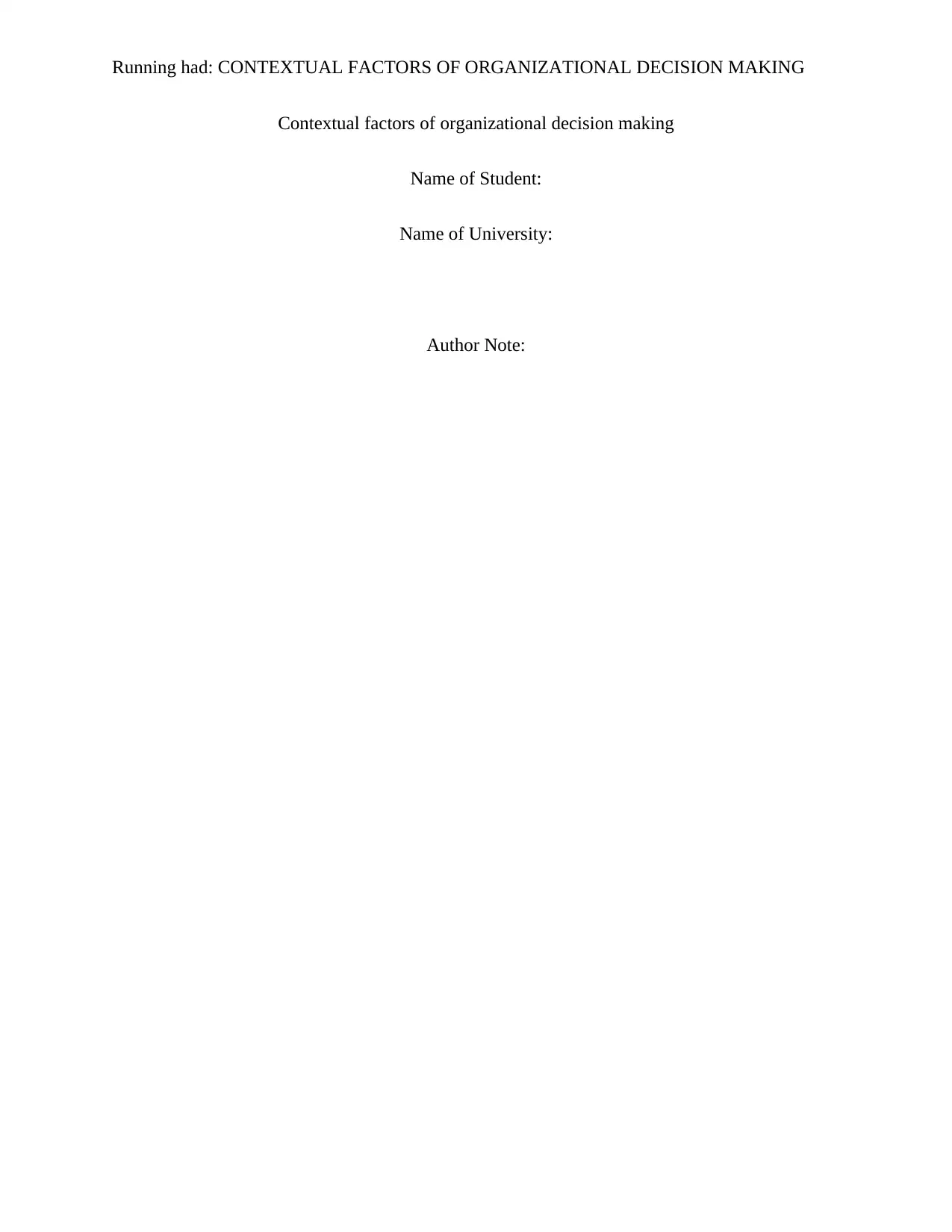
Running had: CONTEXTUAL FACTORS OF ORGANIZATIONAL DECISION MAKING
Contextual factors of organizational decision making
Name of Student:
Name of University:
Author Note:
Contextual factors of organizational decision making
Name of Student:
Name of University:
Author Note:
Paraphrase This Document
Need a fresh take? Get an instant paraphrase of this document with our AI Paraphraser
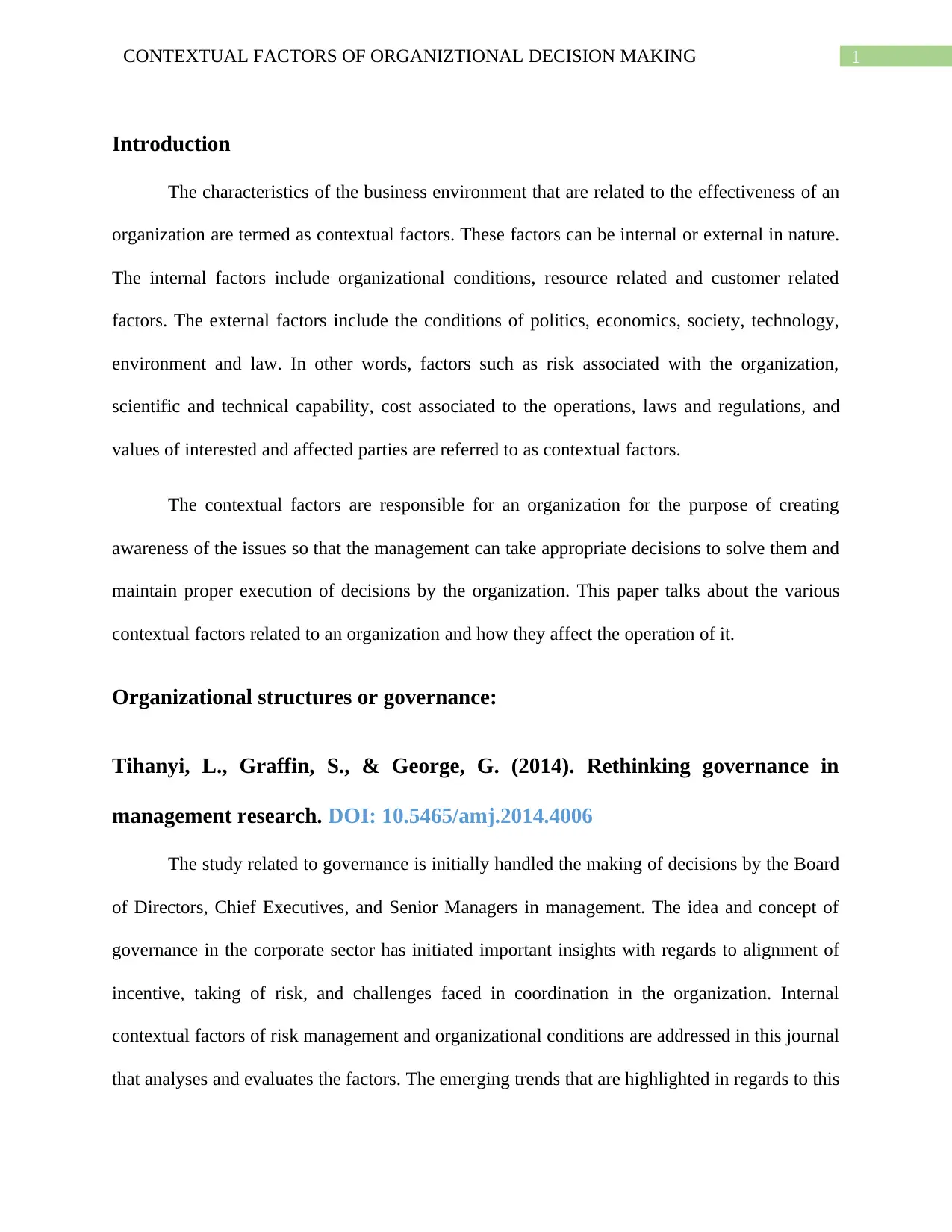
1CONTEXTUAL FACTORS OF ORGANIZTIONAL DECISION MAKING
Introduction
The characteristics of the business environment that are related to the effectiveness of an
organization are termed as contextual factors. These factors can be internal or external in nature.
The internal factors include organizational conditions, resource related and customer related
factors. The external factors include the conditions of politics, economics, society, technology,
environment and law. In other words, factors such as risk associated with the organization,
scientific and technical capability, cost associated to the operations, laws and regulations, and
values of interested and affected parties are referred to as contextual factors.
The contextual factors are responsible for an organization for the purpose of creating
awareness of the issues so that the management can take appropriate decisions to solve them and
maintain proper execution of decisions by the organization. This paper talks about the various
contextual factors related to an organization and how they affect the operation of it.
Organizational structures or governance:
Tihanyi, L., Graffin, S., & George, G. (2014). Rethinking governance in
management research. DOI: 10.5465/amj.2014.4006
The study related to governance is initially handled the making of decisions by the Board
of Directors, Chief Executives, and Senior Managers in management. The idea and concept of
governance in the corporate sector has initiated important insights with regards to alignment of
incentive, taking of risk, and challenges faced in coordination in the organization. Internal
contextual factors of risk management and organizational conditions are addressed in this journal
that analyses and evaluates the factors. The emerging trends that are highlighted in regards to this
Introduction
The characteristics of the business environment that are related to the effectiveness of an
organization are termed as contextual factors. These factors can be internal or external in nature.
The internal factors include organizational conditions, resource related and customer related
factors. The external factors include the conditions of politics, economics, society, technology,
environment and law. In other words, factors such as risk associated with the organization,
scientific and technical capability, cost associated to the operations, laws and regulations, and
values of interested and affected parties are referred to as contextual factors.
The contextual factors are responsible for an organization for the purpose of creating
awareness of the issues so that the management can take appropriate decisions to solve them and
maintain proper execution of decisions by the organization. This paper talks about the various
contextual factors related to an organization and how they affect the operation of it.
Organizational structures or governance:
Tihanyi, L., Graffin, S., & George, G. (2014). Rethinking governance in
management research. DOI: 10.5465/amj.2014.4006
The study related to governance is initially handled the making of decisions by the Board
of Directors, Chief Executives, and Senior Managers in management. The idea and concept of
governance in the corporate sector has initiated important insights with regards to alignment of
incentive, taking of risk, and challenges faced in coordination in the organization. Internal
contextual factors of risk management and organizational conditions are addressed in this journal
that analyses and evaluates the factors. The emerging trends that are highlighted in regards to this
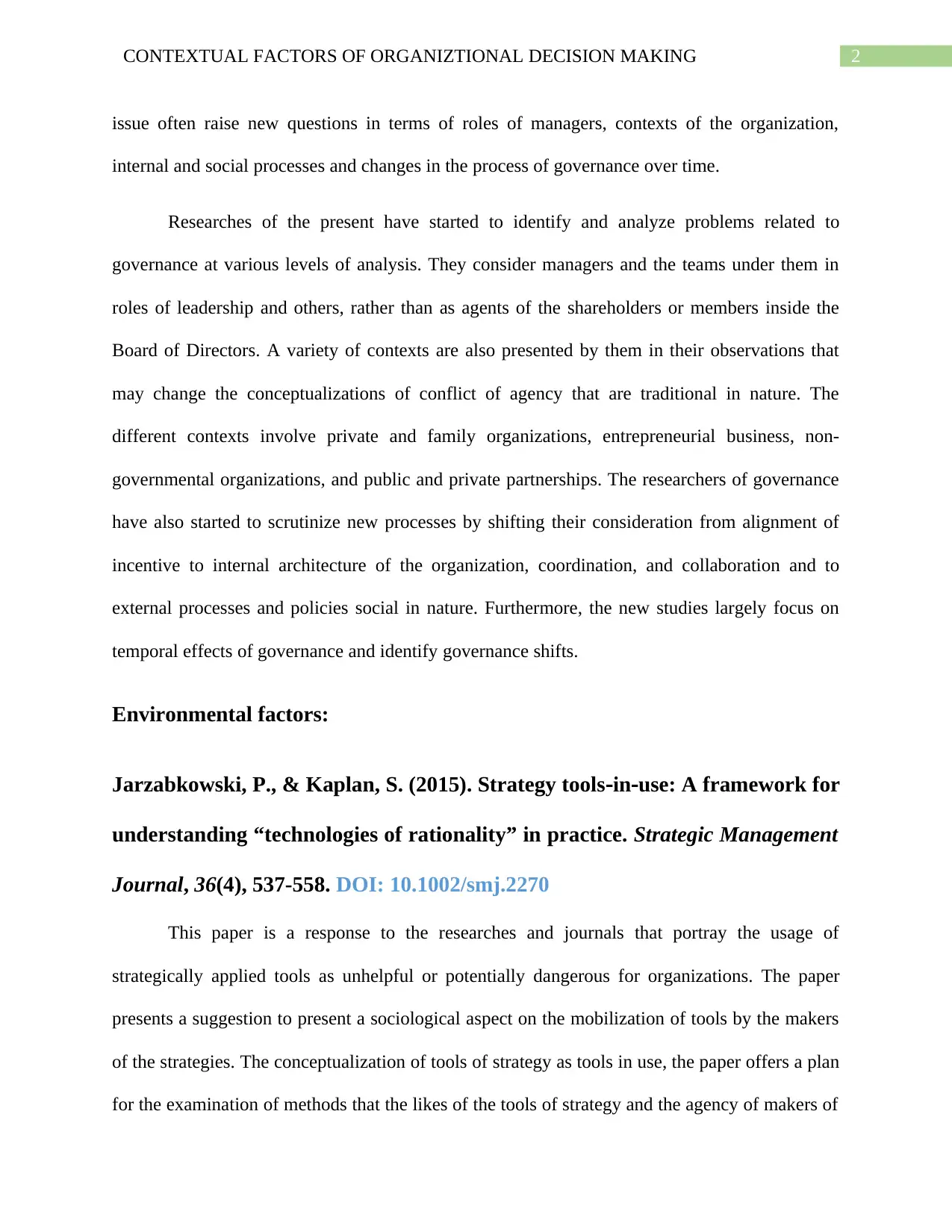
2CONTEXTUAL FACTORS OF ORGANIZTIONAL DECISION MAKING
issue often raise new questions in terms of roles of managers, contexts of the organization,
internal and social processes and changes in the process of governance over time.
Researches of the present have started to identify and analyze problems related to
governance at various levels of analysis. They consider managers and the teams under them in
roles of leadership and others, rather than as agents of the shareholders or members inside the
Board of Directors. A variety of contexts are also presented by them in their observations that
may change the conceptualizations of conflict of agency that are traditional in nature. The
different contexts involve private and family organizations, entrepreneurial business, non-
governmental organizations, and public and private partnerships. The researchers of governance
have also started to scrutinize new processes by shifting their consideration from alignment of
incentive to internal architecture of the organization, coordination, and collaboration and to
external processes and policies social in nature. Furthermore, the new studies largely focus on
temporal effects of governance and identify governance shifts.
Environmental factors:
Jarzabkowski, P., & Kaplan, S. (2015). Strategy tools‐in‐use: A framework for
understanding “technologies of rationality” in practice. Strategic Management
Journal, 36(4), 537-558. DOI: 10.1002/smj.2270
This paper is a response to the researches and journals that portray the usage of
strategically applied tools as unhelpful or potentially dangerous for organizations. The paper
presents a suggestion to present a sociological aspect on the mobilization of tools by the makers
of the strategies. The conceptualization of tools of strategy as tools in use, the paper offers a plan
for the examination of methods that the likes of the tools of strategy and the agency of makers of
issue often raise new questions in terms of roles of managers, contexts of the organization,
internal and social processes and changes in the process of governance over time.
Researches of the present have started to identify and analyze problems related to
governance at various levels of analysis. They consider managers and the teams under them in
roles of leadership and others, rather than as agents of the shareholders or members inside the
Board of Directors. A variety of contexts are also presented by them in their observations that
may change the conceptualizations of conflict of agency that are traditional in nature. The
different contexts involve private and family organizations, entrepreneurial business, non-
governmental organizations, and public and private partnerships. The researchers of governance
have also started to scrutinize new processes by shifting their consideration from alignment of
incentive to internal architecture of the organization, coordination, and collaboration and to
external processes and policies social in nature. Furthermore, the new studies largely focus on
temporal effects of governance and identify governance shifts.
Environmental factors:
Jarzabkowski, P., & Kaplan, S. (2015). Strategy tools‐in‐use: A framework for
understanding “technologies of rationality” in practice. Strategic Management
Journal, 36(4), 537-558. DOI: 10.1002/smj.2270
This paper is a response to the researches and journals that portray the usage of
strategically applied tools as unhelpful or potentially dangerous for organizations. The paper
presents a suggestion to present a sociological aspect on the mobilization of tools by the makers
of the strategies. The conceptualization of tools of strategy as tools in use, the paper offers a plan
for the examination of methods that the likes of the tools of strategy and the agency of makers of
⊘ This is a preview!⊘
Do you want full access?
Subscribe today to unlock all pages.

Trusted by 1+ million students worldwide

3CONTEXTUAL FACTORS OF ORGANIZTIONAL DECISION MAKING
the strategy use interact to determine in what conditions and processes the tools are selected and
applied. The context discussed here is considered as a factor of the business environment that the
organization is operating in. The variety of outcomes as a result of the usage of these tools of
strategy as well as the individuals who use them has been highlighted rather than simply the
evaluation of the proper and improper use of the tools.
A functionalist view of the tools of strategy is visible in the literature while taking the
outcomes into consideration. The outcome suggests that the tools that are used correctly can
assist in achieving the correct results. A failure of achievement of such a result indicates the
deficiency of the tool or the person using the tool. The primary concern in this critique of the
tools of strategy is he risk associated with such technologies of rationality and he disaster that
they would prepare when utilized to find solutions in situations inappropriate in nature.
Risks confronting the firm:
Teece, D., Peteraf, M., & Leih, S. (2016). Dynamic capabilities and
organizational agility: Risk, uncertainty, and strategy in the innovation
economy. California Management Review, 58(4), 13-35. DOI
10.1525/cmr.2016.58.4.13
The term organizational agility is generally considered as an inflexible quality, where it is
implicitly understood and signified that organizations need to be in a constant phase of
transformation. The mentioned statements often ignore the fact that changes and transformations
even though are essential for an organization, come with a cost and at the same time not
necessary at all times. The paper has intended to explore agility of organizations at a basic level
the strategy use interact to determine in what conditions and processes the tools are selected and
applied. The context discussed here is considered as a factor of the business environment that the
organization is operating in. The variety of outcomes as a result of the usage of these tools of
strategy as well as the individuals who use them has been highlighted rather than simply the
evaluation of the proper and improper use of the tools.
A functionalist view of the tools of strategy is visible in the literature while taking the
outcomes into consideration. The outcome suggests that the tools that are used correctly can
assist in achieving the correct results. A failure of achievement of such a result indicates the
deficiency of the tool or the person using the tool. The primary concern in this critique of the
tools of strategy is he risk associated with such technologies of rationality and he disaster that
they would prepare when utilized to find solutions in situations inappropriate in nature.
Risks confronting the firm:
Teece, D., Peteraf, M., & Leih, S. (2016). Dynamic capabilities and
organizational agility: Risk, uncertainty, and strategy in the innovation
economy. California Management Review, 58(4), 13-35. DOI
10.1525/cmr.2016.58.4.13
The term organizational agility is generally considered as an inflexible quality, where it is
implicitly understood and signified that organizations need to be in a constant phase of
transformation. The mentioned statements often ignore the fact that changes and transformations
even though are essential for an organization, come with a cost and at the same time not
necessary at all times. The paper has intended to explore agility of organizations at a basic level
Paraphrase This Document
Need a fresh take? Get an instant paraphrase of this document with our AI Paraphraser
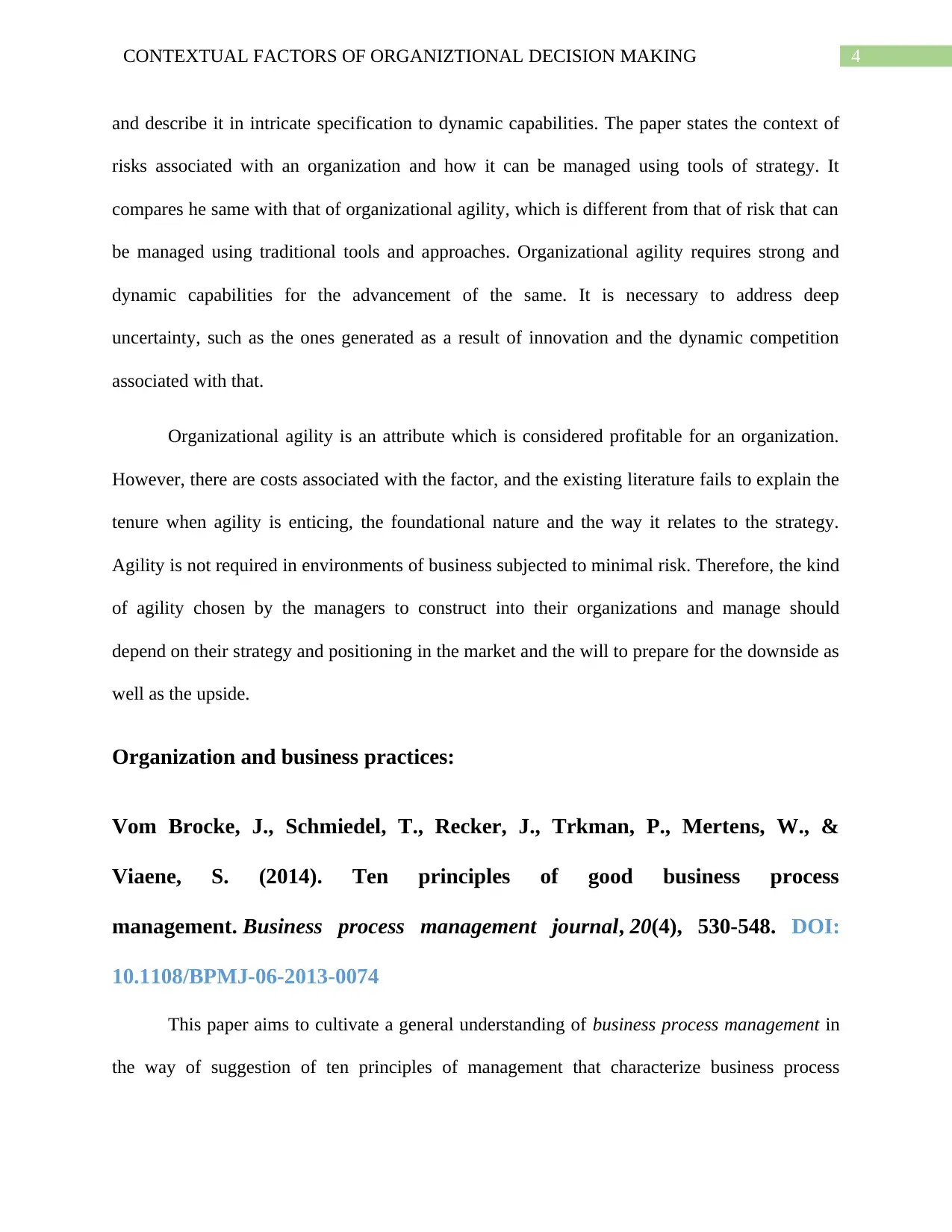
4CONTEXTUAL FACTORS OF ORGANIZTIONAL DECISION MAKING
and describe it in intricate specification to dynamic capabilities. The paper states the context of
risks associated with an organization and how it can be managed using tools of strategy. It
compares he same with that of organizational agility, which is different from that of risk that can
be managed using traditional tools and approaches. Organizational agility requires strong and
dynamic capabilities for the advancement of the same. It is necessary to address deep
uncertainty, such as the ones generated as a result of innovation and the dynamic competition
associated with that.
Organizational agility is an attribute which is considered profitable for an organization.
However, there are costs associated with the factor, and the existing literature fails to explain the
tenure when agility is enticing, the foundational nature and the way it relates to the strategy.
Agility is not required in environments of business subjected to minimal risk. Therefore, the kind
of agility chosen by the managers to construct into their organizations and manage should
depend on their strategy and positioning in the market and the will to prepare for the downside as
well as the upside.
Organization and business practices:
Vom Brocke, J., Schmiedel, T., Recker, J., Trkman, P., Mertens, W., &
Viaene, S. (2014). Ten principles of good business process
management. Business process management journal, 20(4), 530-548. DOI:
10.1108/BPMJ-06-2013-0074
This paper aims to cultivate a general understanding of business process management in
the way of suggestion of ten principles of management that characterize business process
and describe it in intricate specification to dynamic capabilities. The paper states the context of
risks associated with an organization and how it can be managed using tools of strategy. It
compares he same with that of organizational agility, which is different from that of risk that can
be managed using traditional tools and approaches. Organizational agility requires strong and
dynamic capabilities for the advancement of the same. It is necessary to address deep
uncertainty, such as the ones generated as a result of innovation and the dynamic competition
associated with that.
Organizational agility is an attribute which is considered profitable for an organization.
However, there are costs associated with the factor, and the existing literature fails to explain the
tenure when agility is enticing, the foundational nature and the way it relates to the strategy.
Agility is not required in environments of business subjected to minimal risk. Therefore, the kind
of agility chosen by the managers to construct into their organizations and manage should
depend on their strategy and positioning in the market and the will to prepare for the downside as
well as the upside.
Organization and business practices:
Vom Brocke, J., Schmiedel, T., Recker, J., Trkman, P., Mertens, W., &
Viaene, S. (2014). Ten principles of good business process
management. Business process management journal, 20(4), 530-548. DOI:
10.1108/BPMJ-06-2013-0074
This paper aims to cultivate a general understanding of business process management in
the way of suggestion of ten principles of management that characterize business process
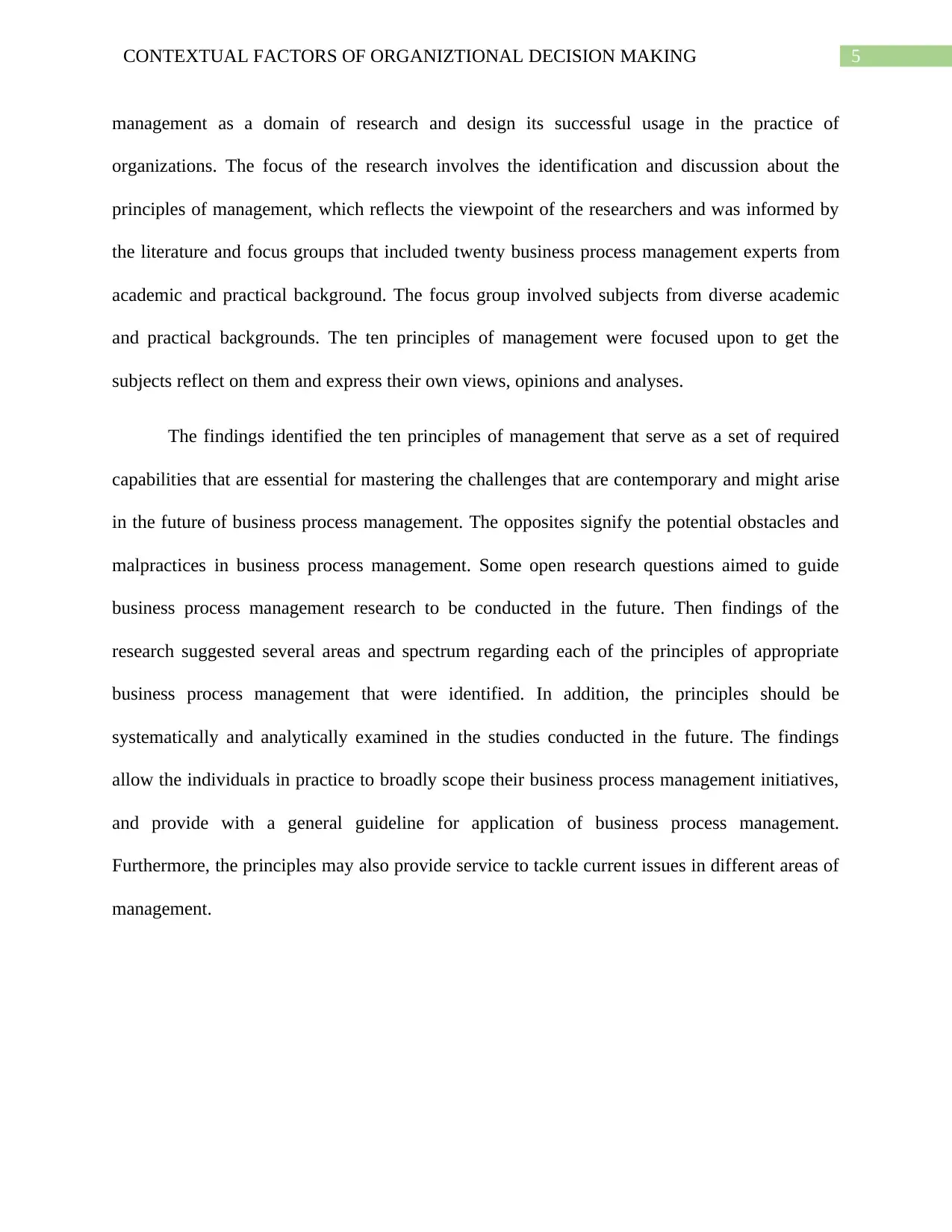
5CONTEXTUAL FACTORS OF ORGANIZTIONAL DECISION MAKING
management as a domain of research and design its successful usage in the practice of
organizations. The focus of the research involves the identification and discussion about the
principles of management, which reflects the viewpoint of the researchers and was informed by
the literature and focus groups that included twenty business process management experts from
academic and practical background. The focus group involved subjects from diverse academic
and practical backgrounds. The ten principles of management were focused upon to get the
subjects reflect on them and express their own views, opinions and analyses.
The findings identified the ten principles of management that serve as a set of required
capabilities that are essential for mastering the challenges that are contemporary and might arise
in the future of business process management. The opposites signify the potential obstacles and
malpractices in business process management. Some open research questions aimed to guide
business process management research to be conducted in the future. Then findings of the
research suggested several areas and spectrum regarding each of the principles of appropriate
business process management that were identified. In addition, the principles should be
systematically and analytically examined in the studies conducted in the future. The findings
allow the individuals in practice to broadly scope their business process management initiatives,
and provide with a general guideline for application of business process management.
Furthermore, the principles may also provide service to tackle current issues in different areas of
management.
management as a domain of research and design its successful usage in the practice of
organizations. The focus of the research involves the identification and discussion about the
principles of management, which reflects the viewpoint of the researchers and was informed by
the literature and focus groups that included twenty business process management experts from
academic and practical background. The focus group involved subjects from diverse academic
and practical backgrounds. The ten principles of management were focused upon to get the
subjects reflect on them and express their own views, opinions and analyses.
The findings identified the ten principles of management that serve as a set of required
capabilities that are essential for mastering the challenges that are contemporary and might arise
in the future of business process management. The opposites signify the potential obstacles and
malpractices in business process management. Some open research questions aimed to guide
business process management research to be conducted in the future. Then findings of the
research suggested several areas and spectrum regarding each of the principles of appropriate
business process management that were identified. In addition, the principles should be
systematically and analytically examined in the studies conducted in the future. The findings
allow the individuals in practice to broadly scope their business process management initiatives,
and provide with a general guideline for application of business process management.
Furthermore, the principles may also provide service to tackle current issues in different areas of
management.
⊘ This is a preview!⊘
Do you want full access?
Subscribe today to unlock all pages.

Trusted by 1+ million students worldwide
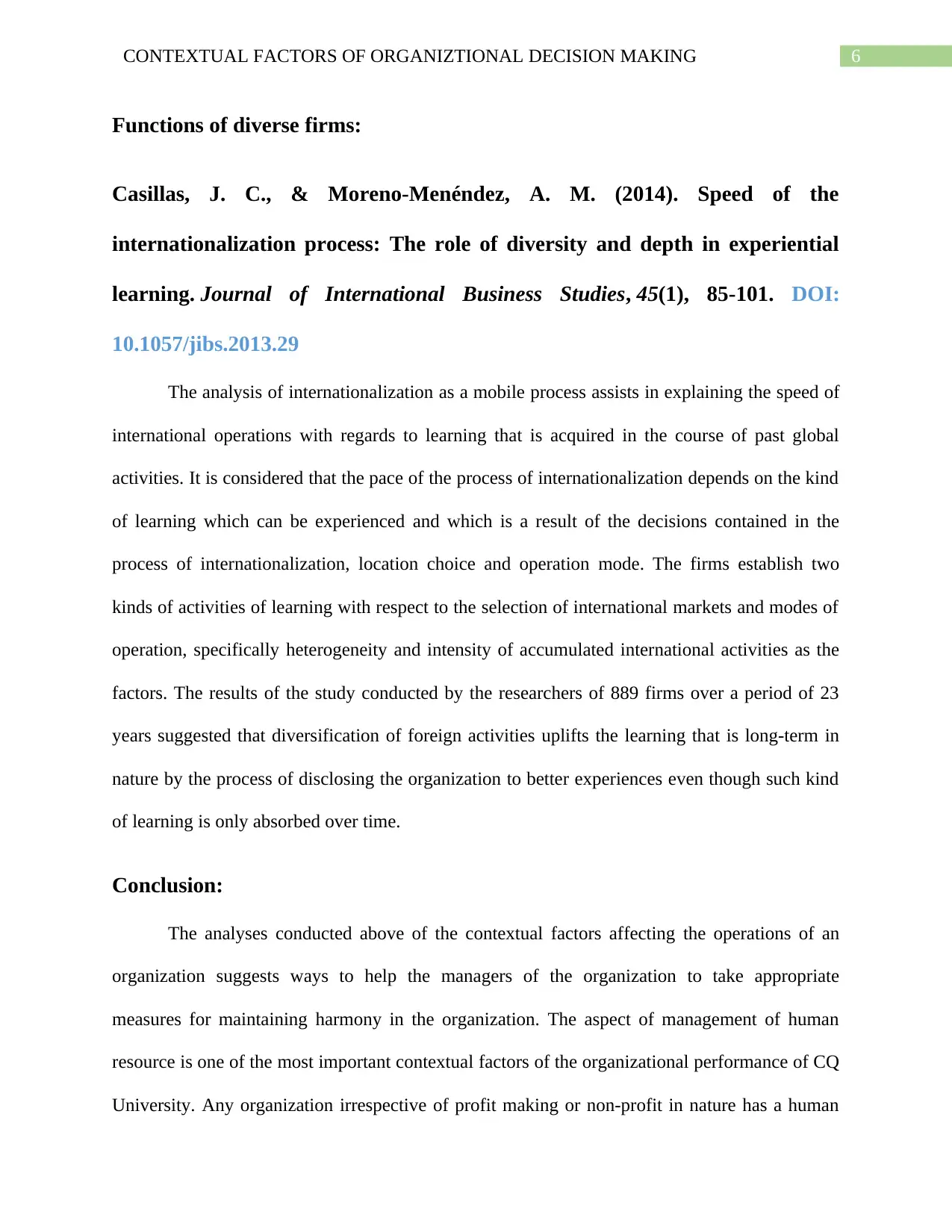
6CONTEXTUAL FACTORS OF ORGANIZTIONAL DECISION MAKING
Functions of diverse firms:
Casillas, J. C., & Moreno-Menéndez, A. M. (2014). Speed of the
internationalization process: The role of diversity and depth in experiential
learning. Journal of International Business Studies, 45(1), 85-101. DOI:
10.1057/jibs.2013.29
The analysis of internationalization as a mobile process assists in explaining the speed of
international operations with regards to learning that is acquired in the course of past global
activities. It is considered that the pace of the process of internationalization depends on the kind
of learning which can be experienced and which is a result of the decisions contained in the
process of internationalization, location choice and operation mode. The firms establish two
kinds of activities of learning with respect to the selection of international markets and modes of
operation, specifically heterogeneity and intensity of accumulated international activities as the
factors. The results of the study conducted by the researchers of 889 firms over a period of 23
years suggested that diversification of foreign activities uplifts the learning that is long-term in
nature by the process of disclosing the organization to better experiences even though such kind
of learning is only absorbed over time.
Conclusion:
The analyses conducted above of the contextual factors affecting the operations of an
organization suggests ways to help the managers of the organization to take appropriate
measures for maintaining harmony in the organization. The aspect of management of human
resource is one of the most important contextual factors of the organizational performance of CQ
University. Any organization irrespective of profit making or non-profit in nature has a human
Functions of diverse firms:
Casillas, J. C., & Moreno-Menéndez, A. M. (2014). Speed of the
internationalization process: The role of diversity and depth in experiential
learning. Journal of International Business Studies, 45(1), 85-101. DOI:
10.1057/jibs.2013.29
The analysis of internationalization as a mobile process assists in explaining the speed of
international operations with regards to learning that is acquired in the course of past global
activities. It is considered that the pace of the process of internationalization depends on the kind
of learning which can be experienced and which is a result of the decisions contained in the
process of internationalization, location choice and operation mode. The firms establish two
kinds of activities of learning with respect to the selection of international markets and modes of
operation, specifically heterogeneity and intensity of accumulated international activities as the
factors. The results of the study conducted by the researchers of 889 firms over a period of 23
years suggested that diversification of foreign activities uplifts the learning that is long-term in
nature by the process of disclosing the organization to better experiences even though such kind
of learning is only absorbed over time.
Conclusion:
The analyses conducted above of the contextual factors affecting the operations of an
organization suggests ways to help the managers of the organization to take appropriate
measures for maintaining harmony in the organization. The aspect of management of human
resource is one of the most important contextual factors of the organizational performance of CQ
University. Any organization irrespective of profit making or non-profit in nature has a human
Paraphrase This Document
Need a fresh take? Get an instant paraphrase of this document with our AI Paraphraser
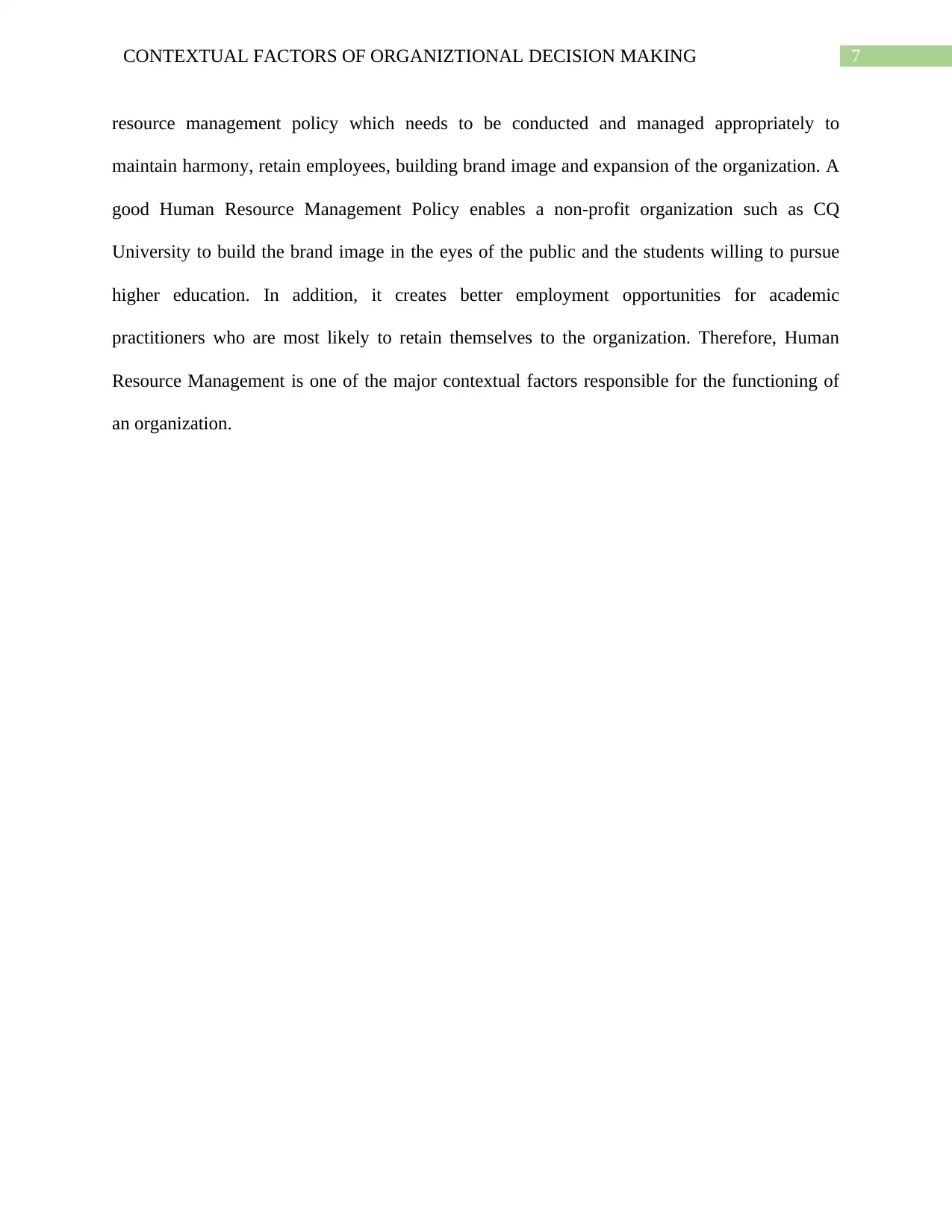
7CONTEXTUAL FACTORS OF ORGANIZTIONAL DECISION MAKING
resource management policy which needs to be conducted and managed appropriately to
maintain harmony, retain employees, building brand image and expansion of the organization. A
good Human Resource Management Policy enables a non-profit organization such as CQ
University to build the brand image in the eyes of the public and the students willing to pursue
higher education. In addition, it creates better employment opportunities for academic
practitioners who are most likely to retain themselves to the organization. Therefore, Human
Resource Management is one of the major contextual factors responsible for the functioning of
an organization.
resource management policy which needs to be conducted and managed appropriately to
maintain harmony, retain employees, building brand image and expansion of the organization. A
good Human Resource Management Policy enables a non-profit organization such as CQ
University to build the brand image in the eyes of the public and the students willing to pursue
higher education. In addition, it creates better employment opportunities for academic
practitioners who are most likely to retain themselves to the organization. Therefore, Human
Resource Management is one of the major contextual factors responsible for the functioning of
an organization.
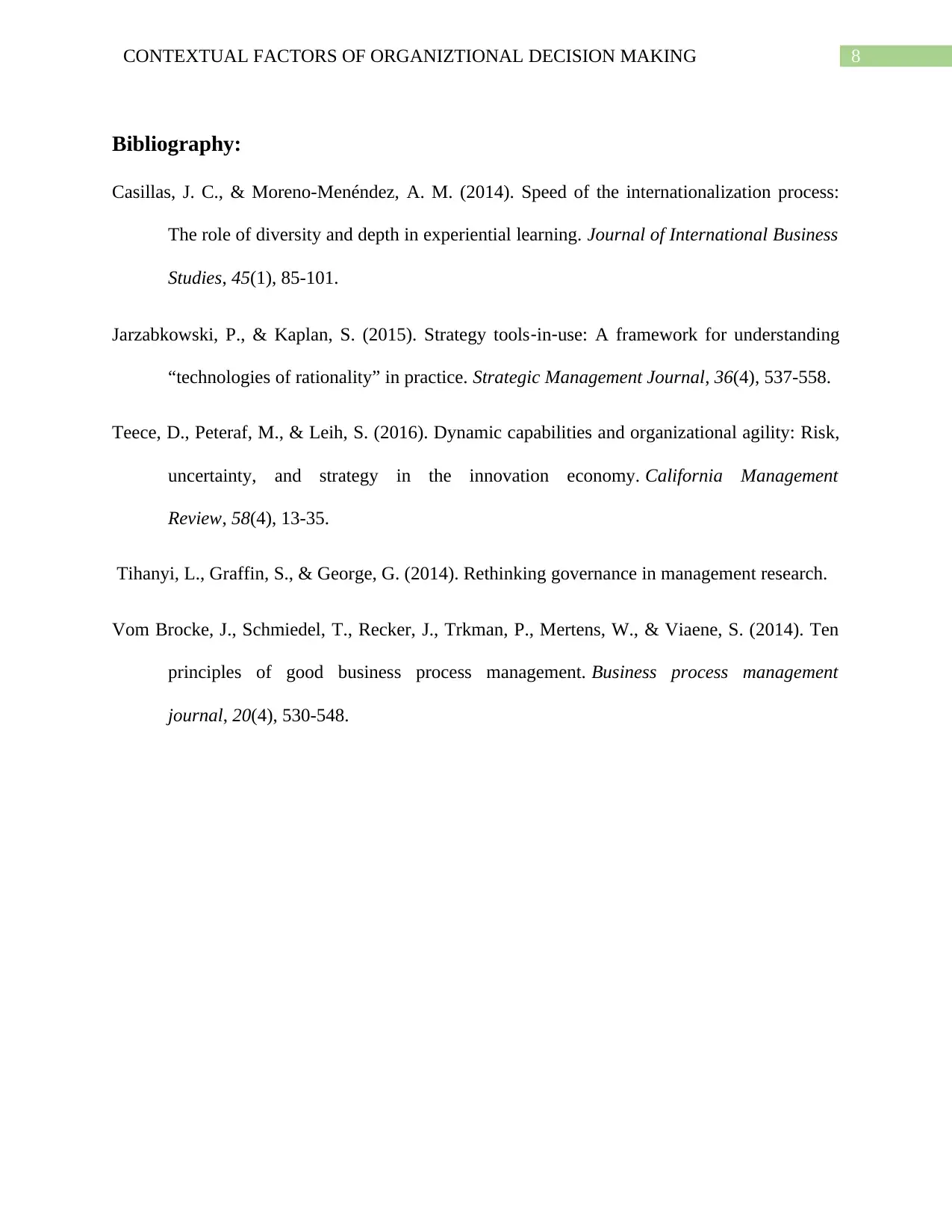
8CONTEXTUAL FACTORS OF ORGANIZTIONAL DECISION MAKING
Bibliography:
Casillas, J. C., & Moreno-Menéndez, A. M. (2014). Speed of the internationalization process:
The role of diversity and depth in experiential learning. Journal of International Business
Studies, 45(1), 85-101.
Jarzabkowski, P., & Kaplan, S. (2015). Strategy tools‐in‐use: A framework for understanding
“technologies of rationality” in practice. Strategic Management Journal, 36(4), 537-558.
Teece, D., Peteraf, M., & Leih, S. (2016). Dynamic capabilities and organizational agility: Risk,
uncertainty, and strategy in the innovation economy. California Management
Review, 58(4), 13-35.
Tihanyi, L., Graffin, S., & George, G. (2014). Rethinking governance in management research.
Vom Brocke, J., Schmiedel, T., Recker, J., Trkman, P., Mertens, W., & Viaene, S. (2014). Ten
principles of good business process management. Business process management
journal, 20(4), 530-548.
Bibliography:
Casillas, J. C., & Moreno-Menéndez, A. M. (2014). Speed of the internationalization process:
The role of diversity and depth in experiential learning. Journal of International Business
Studies, 45(1), 85-101.
Jarzabkowski, P., & Kaplan, S. (2015). Strategy tools‐in‐use: A framework for understanding
“technologies of rationality” in practice. Strategic Management Journal, 36(4), 537-558.
Teece, D., Peteraf, M., & Leih, S. (2016). Dynamic capabilities and organizational agility: Risk,
uncertainty, and strategy in the innovation economy. California Management
Review, 58(4), 13-35.
Tihanyi, L., Graffin, S., & George, G. (2014). Rethinking governance in management research.
Vom Brocke, J., Schmiedel, T., Recker, J., Trkman, P., Mertens, W., & Viaene, S. (2014). Ten
principles of good business process management. Business process management
journal, 20(4), 530-548.
⊘ This is a preview!⊘
Do you want full access?
Subscribe today to unlock all pages.

Trusted by 1+ million students worldwide
1 out of 9
Related Documents
Your All-in-One AI-Powered Toolkit for Academic Success.
+13062052269
info@desklib.com
Available 24*7 on WhatsApp / Email
![[object Object]](/_next/static/media/star-bottom.7253800d.svg)
Unlock your academic potential
Copyright © 2020–2025 A2Z Services. All Rights Reserved. Developed and managed by ZUCOL.



